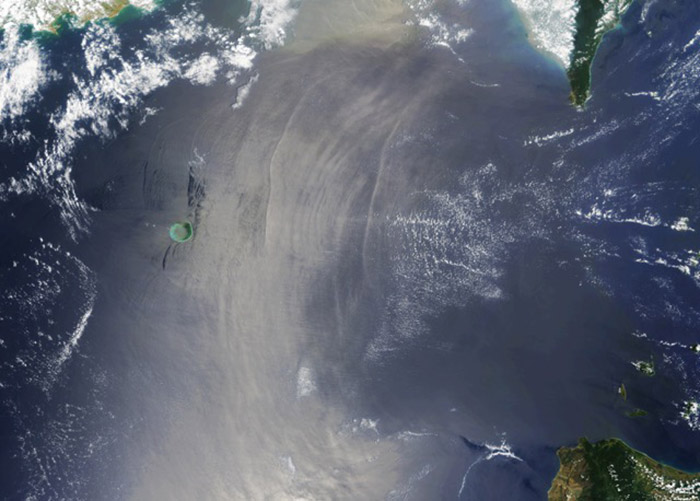Study of Giant South China Sea Internal Waves Provides First-Ever View of Life Cycle
Emerging science could revise sea-level rise predictions, improve undersea navigation, and revolutionize understanding of how nutrients reach coastal marine ecosystems
By:
- Robert Monroe
Media Contact:
- Robert Monroe - scrippsnews@ucsd.edu
- Mario Aguilera - maguilera@ucsd.edu
Published Date
By:
- Robert Monroe
Share This:
Article Content
An international research team that included physical oceanographers at Scripps Institution of Oceanography, UC San Diego, characterized for the first time the entire life cycle of internal ocean waves that can reach 500 meters (1,600 feet) in height before breaking.
In the study, the researchers observed internal waves that break in the South China Sea. These are the largest waves produced in the world’s oceans, producing up to 10,000 times the amount of turbulence typically found in the open ocean.

South China Sea internal waves seen from space. Photo: NASA and Global Ocean Associates
The study, “The formation and fate of internal waves in the South China Sea,” appears in the May 7 issue of Nature.
The observations included for the first time very challenging measurements made at the waves’ point of origin in the Luzon Strait between Taiwan and the Philippines.
The Office of Naval Research (ONR) and the Taiwan National Science Council funded the five-year project known as the Internal Waves in Straits Experiment (IWISE). IWISE’s conclusions have broad implications for east Asia, informing the operations of the heavy surface and submarine traffic in the region, the future of low-lying islands most vulnerable to sea-level rise, and the management of some of the world’s largest fisheries.
“The waves are not subtle, as they are visible from space, capable of hampering navigation, and strong enough that pilot whales know to forage in their wakes. How much turbulence they create is a big source of uncertainty in computer climate predictions,” said Scripps physical oceanographer Matthew Alford, the study’s lead author. “Having waves or no waves in those models affects sea-level-rise predictions 50 years from now by over a foot, as much as the other main uncertainties, clouds and sea ice. A better understanding of internal waves will lead to better climate predictions.”
The researchers used a combination of Luzon Strait data and models to recreate the life span of the South China Sea’s internal waves. The waves draw their initial energy from tidal forces and grow as they travel west across the sea, reaching heights greater than 1,000 feet in places. They then break on the continental shelf on the eastern coasts of Vietnam and China in an enormous release of energy that is virtually invisible on the surface.
This release, a process repeated daily, has substantial effects below the surface. Researchers believe it is a delivery mechanism for nutrients that make those coastal regions’ fertile fishing grounds. Closer to home, Alford said that internal wave activity and the nutrients they bring to the surface could similarly be a key driver of the rich marine biodiversity found in places like the La Jolla Kelp Forest.
“IWISE was a great collaboration,” said Frank Herr, head of the Ocean Battlespace Sensing Department at the Office of Naval Research. “We were all surprised with the extent of the energy in these internal waves.”
Besides Alford, Scripps and UC San Diego researchers who contributed to IWISE include Jennifer Mackinnon, Luca Centurioni, Shaun Johnston, Ruth Musgrave, Rob Pinkel, Dan Rudnick, and Sutanu Sarkar. Researchers from the University of Washington, the Massachusetts Institute of Technology, Oregon State University, University of Southern Mississippi, the University of Maryland, National Taiwan University, University of Rhode Island, Stanford University, National Sun-Yat Sen University of Taiwan, Naval Research Laboratory, University of Miami, Woods Hole Oceanographic Institution, Florida Institute of Technology, Global Ocean Associates, University of Victoria, Princeton University, Institut de Mecanique Fluides of Toulouse, France, Korea Institute of Science and Technology, Soliton Ocean Services, University of North Carolina, University of Alaska at Fairbanks, Colorado State University, and ONR also contributed to the study.
Share This:
You May Also Like
Stay in the Know
Keep up with all the latest from UC San Diego. Subscribe to the newsletter today.



